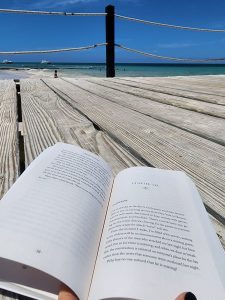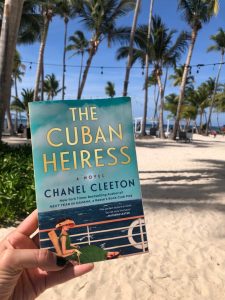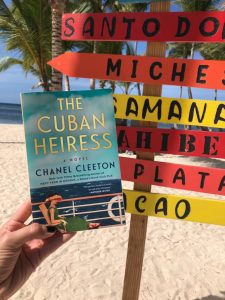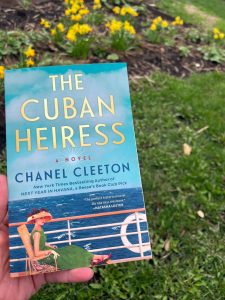
The Cuban Heiress
By Chanel Cleeton
In 1934, a luxury cruise becomes a fight for survival as two women’s pasts collide on a round-trip voyage from New York to Havana in New York Times bestselling author Chanel Cleeton’s page-turning new novel inspired by the true story of the SS Morro Castle.
New York heiress Catherine Dohan seemingly has it all. There’s only one problem. It’s a lie. As soon as the Morro Castle leaves port, Catherine’s past returns with a vengeance and threatens her life. Joining forces with a charismatic jewel thief, Catherine must discover who wants her dead—and why.
Elena Palacio is a dead woman. Or so everyone thinks. After a devastating betrayal left her penniless and on the run, Elena’s journey on the Morro Castle is her last hope. Steeped in secrecy and a burning desire for revenge, her return to Havana is a chance to right the wrong that has been done to her—and her prey is on the ship.
As danger swirls aboard the Morro Castle and their fates intertwine, Elena and Catherine must risk everything to see justice served once and for all.

About the author

Chanel Cleeton is the New York Times and USA Today bestselling author of Reese Witherspoon Book Club pick Next Year in Havana, When We Left Cuba, The Last Train to Key West, The Most Beautiful Girl in Cuba, Our Last Days in Barcelona, and The Cuban Heiress.
Originally from Florida, Chanel grew up on stories of her family’s exodus from Cuba following the events of the Cuban Revolution. Her passion for politics and history continued during her years spent studying in England where she earned a bachelor’s degree in International Relations from Richmond, The American International University in London and a master’s degree in Global Politics from the London School of Economics & Political Science. Chanel also received her Juris Doctor from the University of South Carolina School of Law.
Other Books by author: CUBAN SAGA – Time setting:
- Next Year in Havana– 1958/2017
- When We Left Cuba- 1960
- The Last Train to Key West- 1935
- The Most Beautiful Girl in Cuba- 1896
- Our Last Days in Barcelona- 1936/1964
- The Cuban Heiress– 1934
- The House on Biscayne Bay

![NextYearinHavanna_FCO_RW[2]+copy](https://btwthewinesbookclub.com/wp-content/uploads/2023/05/NextYearinHavanna_FCO_RW2copy-1.jpg)





Into The Book

What to drink

Of course, Mojitos!!
Ingredients:
1 Slice lemon
6 Mint leaves
2 tablespoon of sugar
4 tablespoons of chinola juice
2 tablespoon of coconut milk
2 onz of rum
Ice + Sparkling water
Instructions:
Slice the lemon in a tall glass, add mint, sugar, smash it a bit. Then add juice, coconut milk, Rum, Ice and fill up with sparkling water. For decoration add Chinola and mint leaves.
What to eat
Ingredients:
2 pounds of beef brisket
1 Tbsp. of oil
1 chopped onion
¼ Cup of tomato paste
1 Laurel Leaf
½ tablespoon dried oregano
2 Cups of crushed tomatoes
¼ cup of red wine
2 red peppers chopped
3 crushed garlic cloves
Salt and pepper
Preparation:
Boil the meat with 1 chopped onion and pepper. When it starts to boil, cover, lower the heat and let it boil until is soft. Let it cool in the water. Remove, crumble and reserve the liquid where you cooked it
In a separate frying pan, pour the oil, add the onion, tomato paste, laurel leaf, oregano, crushed tomatoes, garlic, the meat cooking broth, cook until it takes consistency, add the meat and cook wine for 10 minutes and finally add the peppers and salt. Mix and serve.

If you ever decide to go to Cuba, belong some cruise recommendations:
https://www.ncl.com.mx/Cruceros-a-Cuba/Norwegian-Cruise-Line/5wzaq/
The Famous Cuban Cigars:
When Spanish sailors first explored Cuba in 1492, they returned with accounts of tall forests, chattering birds, and men and women going from place to place “with a firebrand of weeds in their hands to take in the fragrant smoke.”
Before long, Spanish colonists were growing and smoking tobacco too. As the demand for tobacco spread, the “weeds” became a profitable crop. Cuba opened its first cigar factories in the early 1800s. Today, cigars are still one of Cuba’s leading exports, shipped by the millions around the world.

1492 Columbus “discovers” indigenous tobacco in Cuba and takes it back to the Old World.
1511 Spain takes control of Cuba.
1614 La Casa de Contratatacion de la Habana formed to develop tobacco production in Cuba.
1717 Royal monopoly control on tobacco growing in Cuba imposed and vigorously enforced.
1817 Tobacco industry monopoly ends and a boom in cigar production export commences.
1898 The Spanish–American war brings provisional independence to Cuba administered by the United States. The American / British buy-out begins.
1902 Cuba gained formal independence from the United States on 20 May 1902, as the Republic of Cuba.
1920 Cigar making machines introduced into Cuba.
1959 The Revolution occurs (ousting corrupt President Batista) and Fidel Castro takes control of Cuba under a communist regime.
1960 Castro nationalises the Cuban cigar industry on 15 September 1960. For more detail, see below.
1962 Empresa Cubana del Tabaco (Cubatabaco) was formed and over one hundred export brands discontinued.
1962/3 The 1962 Cuban Missile crisis results in a USA embargo. Full restrictions are enforced in 1963.
1980 Cuban factory Vitolas de Galera names are reduced and rationalised. For more detail, see below.
1992 Start of Cuba’s Special Period, a near decade of economic crisis following the collapse of the Soviet Union (who had been propping up Castro & Cuba).
1994 Habanos Sociedad Anomina (Habanos S.A) created as the commercial (sales) arm of Cubatabaco. Cubatabaco retains control of all aspects of cigar production.
1999 Altadis S.A. formed by merger between Spain’s Tabacalera S.A. and France’s SEITA.
2000 Altadis S.A. purchases a 50% share in Habanos S.A.
2001 Tabacuba formed and takes over from Cubatabaco as the manufacturing arm of Habanos S.A. Internacional Cubana de Tabacos S.A. formed to manufacture & promote the Guantanamera brand and the various brands of mini cigars (mini, club, & puritos).
2002 A major policy change is introduced. Over the next five years, many low-selling vitolas are discontinued and all machine-made production switches to handmade. New release categories are introduced, emphasising limited volume special edition cigars. Technological and process improvements improve production quality.
2007 Altadis (a French-Spanish company) has accepts a bid of €50 a share from Britain’s Imperial Tobacco (valuing the company at €12.6 billion, for its 252,436,856 shares). Altadis holds a 50% share of Habanos SA. Fidel Castro’s illness triggers speculation of the end of the US embargo. This, combined with the pending merger, raises concerns among collectors regarding supply, quality and pricing of Cuban cigars.
2008 The final sale/transfer of Altadis to BIT finalised. Fidel Castro announces his retirement as President of the Council of State, and Commander-in-Chief. He remains leader of the Cuban Communist Party. His brother, Raúl Castro, assumes the presidency and implements various reforms in Cuba.
2010 Major figures in the Cuban cigar industry are arrested for alleged corruption. Although these allegations are never proven, it nonetheless results in a shakeup of the leadership of the Cuban side of Habanos S.A.
2019 Imperial Brands plc (Imperial Tobacco had renamed in 2016) announces that it is seeking bidders for its premium tobacco business, including its 50% stake in Habanos S.A.
2020 In April 2020, Imperial Brands announced that it had reached an agreement to sell its tobacco businesses, with the international portion including Altidas and the Habanos S.A. stake to be sold to Allied Cigar Corporation SL. Allied Cigar appears to be a holding company, the ownership of which is not clear. The sale closes in October of 2020.
How to read Mexican Gothic
You May Also Like

Wish You Were Here
May 11, 2023
Someone Else’s Shoes
May 11, 2023


































